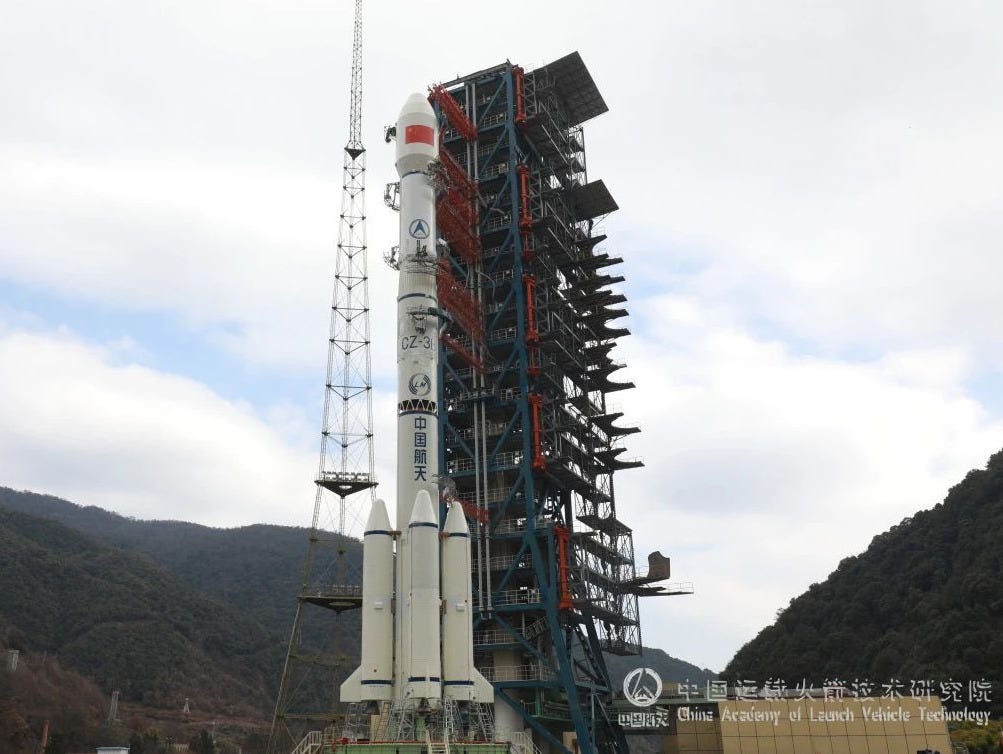New TJSW Satellite Heads for Geostationary Orbit [Long March 3B/E Y106]
Another TJSW satellite has reached orbit for the Long March 3B/E's second flight this year.

A Long March 3B/E blasted off from Launch Complex 2 at the Xichang Satellite Launch Center at 23:32 pm China Standard Time, or 15:32 pm Universal Coordinated Time, on January 23rd heading for geostationary transfer orbit. Ten hours earlier another Long March rocket also headed to orbit.
Riding atop of the Long March 3B/E today was the TJSW-14 satellite (通信技术试验卫星十四号), known as Communication Technology Experimental Satellite-14 in English, and developed by the Shanghai Academy of Spaceflight Technology. Like the previous two TJSW satellites, uses may include satellite communications, radio, television, data transmission, as well as technology testing and verification.
In their post-launch blog post, the China Academy of Launch Vehicle Technology emphasized that this launch came shortly after the rocket’s first mission of the year, thanks to improved design reliability, production efficiency, and autonomous control systems. The academy added that various missions will be undertaken by the Long March 3B/E this year, such as various commercial satellite launches and deep space exploration missions, including Tianwen-2.

Speaking after the Long March 3B/E’s flight on January 7th, the China Aerospace Science and Technology Corporation expects the rocket to perform over ten missions in 2025. An increased cadence is said to be possible thanks to continuous optimizations to vehicle production, testing, launch preparations, and team training.
Toward the end of last year, the China Academy of Launch Vehicle Technology stated that they were aiming to launch the Long March 3B/E over a dozen times per year. To support this the academy said:
“In response to the needs of high-density launch missions, the model team innovatively proposed management methods and processes such as de-tasking. The Long March 3A [consisting of Long March 3A, 3B, 3C] series of rockets has become the first launch vehicle in China to carry out group batch production and use dual-station cross-parallel integrated testing, assembly and factory testing. It is the first launch vehicle to realize a team to carry out test launches of two rockets at the same time at the launch site, with the shortest interval of 15 days for the launch of a rocket.”
If there are any problems with this translation please reach out and correct me.
Today’s mission was the 103rd launch of a Long March 3B vehicle, the 558th launch of the Long March launch vehicle series. This was also the 6th launch from China in 2025.
Liftoff video via 我们的太空新媒体中心 on WeChat.
Post-release update
Sadly either the first-stage or booster, it is unknown which at this time, fell close to a residential area at roughly 23:50 pm local time. Few details about where part of the rocket fell have been released, India Today believes it fell in Zhenyuan County (镇远县), Guizhou Province (贵州).
As is standard after booster-related incidents, nearby residents have been asked to shelter outside and away from the debris. Meanwhile, teams will close off and clean up the debris shortly.
As of writing (January 23rd), the Y number for this launch is believed to be Y106, this article will be updated if clarified otherwise.
Chinese companies, state-owned and private, use Y followed by a number to serialize launch mission numbering, similar to NASA with STS.
Check out the previous Long March 3B/E launch
What is the Long March 3B/E?
This section is for those less familiar with China's Long March series of launch vehicles.
The Long March 3B is an older-generation geostationary orbit workhorse of the China Academy of Launch Vehicle Technology. The first two stages and four boosters of the rocket burn Dinitrogen Tetroxide and Unsymmetrical Dimethylhydrazine, with liquid hydrogen and liquid oxygen in the third-stage.
Over the rocket's almost twenty-eight-year launch history, two versions of the vehicle have flown, the 3B and 3B/E. Since 2012 only the 3B/E variant has flown due to its increased payload capacity. The payload capacity of the launch vehicle is currently as follows:
11,500 kilograms to low Earth orbit
7,100 kilograms to a sun-synchronous orbit
5,500 kilograms into a geostationary transfer orbit
2,000 kilograms into geostationary orbit
The first-stage is powered by four YF-21C engines that burn Dinitrogen Tetroxide and Unsymmetrical Dimethylhydrazine to generate 302 tons of thurst, while the boosters are powered by one YF-25 engine burning the same fuel to generate 72 tons of thrust each. Combined the four boosters and first stage generate a thrust of 590 tons. The second stage is powered by one YF-22E and four YF-23F vernier engines that also burn Dinitrogen Tetroxide and Unsymmetrical Dimethylhydrazine to generate 81 tons of thrust. The third-stage is powered by two YF-75 engines that burn liquid hydrogen and liquid oxygen to generate 17 tons of thrust.
On the launch pad, the Long March 3B/E is 56.3 meters tall and weighs 458,970 kilograms when fully fuelled. The first and second-stage have a diameter of 3.35 meters, while the third-stage has a diameter of 3 meters, along with the four boosters diameter of 2.25 meters, and the fairing has a diameter of 4.2 meters.
So far every Long March 3B launch has occurred from the Xichang Satellite Launch Center, in the south of Sichuan province.





